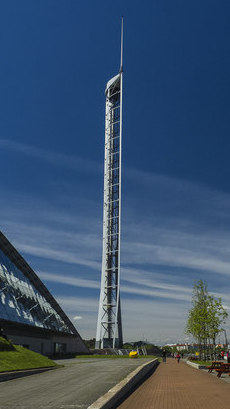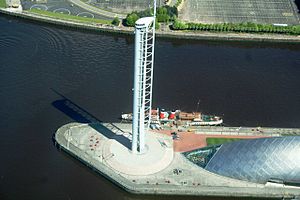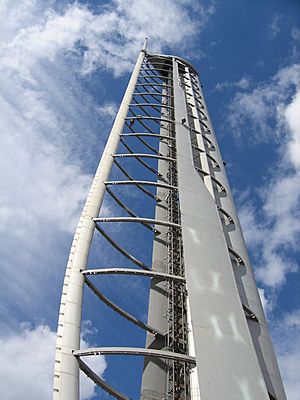Glasgow Tower facts for kids
Quick facts for kids Glasgow TowerMillenium Tower (2001) |
|
|---|---|
 |
|
| Record height | |
| Tallest in Scotland since 2001 | |
| Preceded by | Bluevale and Whitevale Towers |
| General information | |
| Type | Observation tower |
| Location | Glasgow, Scotland |
| Coordinates | 55°51′33″N 4°17′46″W / 55.8592°N 4.2961°W |
| Completed | 2001 |
| Height | |
| Antenna spire | 127 m (417 ft) |
| Design and construction | |
| Architect | Richard Horden |
| Structural engineer | Buro Happold |
| Awards and prizes | Holds a Guinness World Record for being the tallest tower in the world in which the whole structure is capable of rotating 360 degrees. |
The Glasgow Tower is a super tall building in Glasgow, Scotland. It stands 127 metres (417 ft) high. This amazing observation tower is located on the south bank of the River Clyde. It is part of the Glasgow Science Centre complex.
The Glasgow Tower holds a special Guinness World Record. It is the tallest tower in the world that can spin all the way around (360 degrees). The tower was closed for a while for important updates. It then re-opened to visitors in July 2014. Since it was finished in 2001, the Glasgow Tower has been the tallest building in both Glasgow and Scotland.
Contents
Amazing Facts About the Tower
The Glasgow Tower is the tallest tower in Scotland. It stands at 127 metres (417 ft) tall. Since 2015, it has also been the tallest building in all of Glasgow. This happened after some other tall buildings were taken down.
The tower is famous for its Guinness World Record. It is the tallest tower in the world that can fully rotate. This means the whole building can turn 360 degrees. The tower rests on a special bearing. This bearing helps it to spin smoothly. It also helps the tower face into the wind. This makes it more stable.
The tower is not directly connected to its foundations. Instead, it sits on a ring of 24 special roller bearings. These bearings have rubber springs. This design allows the tower to rotate.
Getting to the Top
The Glasgow Tower has two lifts. Each lift can hold up to 12 people. However, for comfort, they usually take only 6 guests and one staff member. These lifts go up the tower very quickly. It takes about two and a half minutes to reach the top. As you go up, you can see amazing views through the glass windows.
There is also an emergency staircase inside the tower. It has 523 steps. This staircase goes from the observation deck all the way down to the ground level.
A Look Back: The Tower's Journey
The Glasgow Tower has had some challenges since it was built. It even missed its first opening date in 2001. There were problems with the special bearing that helps it spin. Because of this, the tower was closed for a long time. It was shut from February 2002 until August 2004.
In January 2005, a group of ten people got stuck in the lifts. It took over five hours to help them get out. After this event, the tower re-opened in December 2006.
Events and Closures
In September 2007, a charity event took place at the tower. People were able to abseil down the side of the building. The Science Centre says that 65,000 people have visited the tower when it has been open.
In August 2010, the tower closed again. This was due to some technical problems with its original design. Before it re-opened in 2014, the main bearing was replaced. This fix was even shown on a TV show called "Incredible Engineering Blunders: Fixed."
The tower opened again to the public in July 2014. It had new safety features and a refreshed inside. The tower now operates during the summer months. This is usually between April and October. Visitors can go up to the observation deck, which is 100 metres (328 ft) high. However, it only opens when the wind is not too strong. This makes sure everyone is comfortable and safe.
A few days after it re-opened, a small problem happened at the base. Some smoke appeared, but it was not a fire.
Cool Design Features
The Glasgow Tower has a very unique shape. It looks like an aerofoil. This is like an airplane wing standing straight up. This shape helps the tower deal with strong winds. It has four motors that turn it into the wind. This reduces wind resistance and makes the tower more stable.
The tower was once called the Millennium Tower. Its design won an international competition. The first design was by architect Richard Horden. The engineering was done by Buro Happold. Later, Glasgow architects BDP took over the project. The tower cost about £10 million to build.
Is it Scotland's Tallest Building?
When the Glasgow Tower was finished in 2001, it was the second tallest self-supporting structure in Scotland. The chimney at Inverkip power station was taller. The tower's website says it is "The tallest freestanding building in Scotland."
The tower has an observation deck at 100 metres (328 ft). However, it does not have floors all the way from the ground up. Because of this, some groups, like the Council on Tall Buildings and Urban Habitat (CTBUH), do not consider it a traditional "building." They see it more as a "structure."



